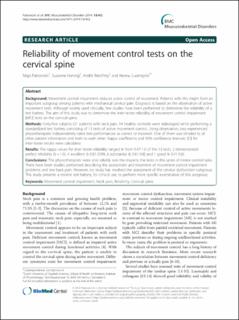Please use this identifier to cite or link to this item:
https://doi.org/10.21256/zhaw-1932| Publication type: | Article in scientific journal |
| Type of review: | Peer review (publication) |
| Title: | Reliability of movement control tests on the cervical spine |
| Authors: | Patroncini, Maja Hannig, Susanne Meichtry, André Luomajoki, Hannu |
| DOI: | 10.21256/zhaw-1932 10.1186/1471-2474-15-402 |
| Published in: | BMC Musculoskeletal Disorders |
| Volume(Issue): | 15 |
| Issue: | 402 |
| Issue Date: | 2014 |
| Publisher / Ed. Institution: | BioMed Central |
| ISSN: | 1471-2474 |
| Language: | English |
| Subjects: | Movement control impairment; Neck pain; Reliability; Cervical spine |
| Subject (DDC): | 617.5: Orthopaedic surgery |
| Abstract: | Background: Movement control impairment reduces active control of movement. Patients with this might form an important subgroup among patients with mechanical cervical pain. Diagnosis is based on the observation of active movement tests. Although widely used clinically, few studies have been performed to determine the reliability of a test battery. The aim of this study was to determine the inter-tester reliability of movement control impairment [MCI] tests on the cervical spine. Methods: Forty-five subjects (31 patients with neck pain, 14 healthy controls) were videotaped while performing a standardized test battery consisting of 13 tests of active movement control. Using observation, two experienced physiotherapists independently rated test performances as correct or incorrect. One of them was blinded to all other patient information and both to each other. Kappa coefficients and 95% confidence intervals [CI] for inter-tester results were calculated. Results: The kappa values for inter-tester reliability ranged in from 0.47-1.0 of the 13 tests, 2 demonstrated perfect reliability (k = 1.0), 4 excellent (k 0.81-0.99), 6 substantial (k 0.61-0.8) and 1 good (k 0.41-0.6). Conclusions: The physiotherapists were able reliably rate the majority the tests in this series of motor control tasks. There have been studies performed describing the assessment and treatment of movement control impairment problems and low back pain. However, no study has involved the assessment of the cervical dysfunction subgroup. This study presents a reliable test battery, for clinical use, to perform more specific examination of this subgroup. |
| URI: | https://digitalcollection.zhaw.ch/handle/11475/4850 |
| Fulltext version: | Published version |
| License (according to publishing contract): | CC BY 4.0: Attribution 4.0 International |
| Departement: | School of Health Sciences |
| Organisational Unit: | Institute of Physiotherapy (IPT) |
| Appears in collections: | Publikationen Gesundheit |
Files in This Item:
| File | Description | Size | Format | |
|---|---|---|---|---|
| 2014_Patrocini_Reliability of movement_BMC Musculoskeletal Disorders.pdf | 935.41 kB | Adobe PDF |  View/Open |
Show full item record
Patroncini, M., Hannig, S., Meichtry, A., & Luomajoki, H. (2014). Reliability of movement control tests on the cervical spine. BMC Musculoskeletal Disorders, 15(402). https://doi.org/10.21256/zhaw-1932
Patroncini, M. et al. (2014) ‘Reliability of movement control tests on the cervical spine’, BMC Musculoskeletal Disorders, 15(402). Available at: https://doi.org/10.21256/zhaw-1932.
M. Patroncini, S. Hannig, A. Meichtry, and H. Luomajoki, “Reliability of movement control tests on the cervical spine,” BMC Musculoskeletal Disorders, vol. 15, no. 402, 2014, doi: 10.21256/zhaw-1932.
PATRONCINI, Maja, Susanne HANNIG, André MEICHTRY und Hannu LUOMAJOKI, 2014. Reliability of movement control tests on the cervical spine. BMC Musculoskeletal Disorders. 2014. Bd. 15, Nr. 402. DOI 10.21256/zhaw-1932
Patroncini, Maja, Susanne Hannig, André Meichtry, and Hannu Luomajoki. 2014. “Reliability of Movement Control Tests on the Cervical Spine.” BMC Musculoskeletal Disorders 15 (402). https://doi.org/10.21256/zhaw-1932.
Patroncini, Maja, et al. “Reliability of Movement Control Tests on the Cervical Spine.” BMC Musculoskeletal Disorders, vol. 15, no. 402, 2014, https://doi.org/10.21256/zhaw-1932.
Items in DSpace are protected by copyright, with all rights reserved, unless otherwise indicated.